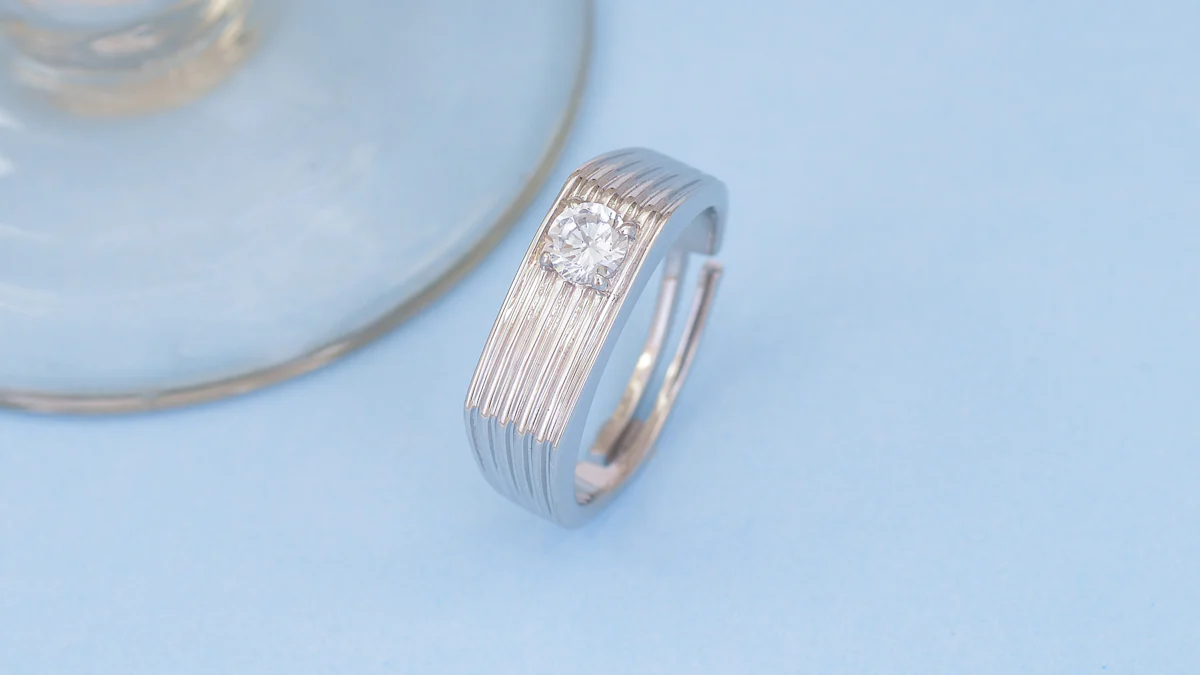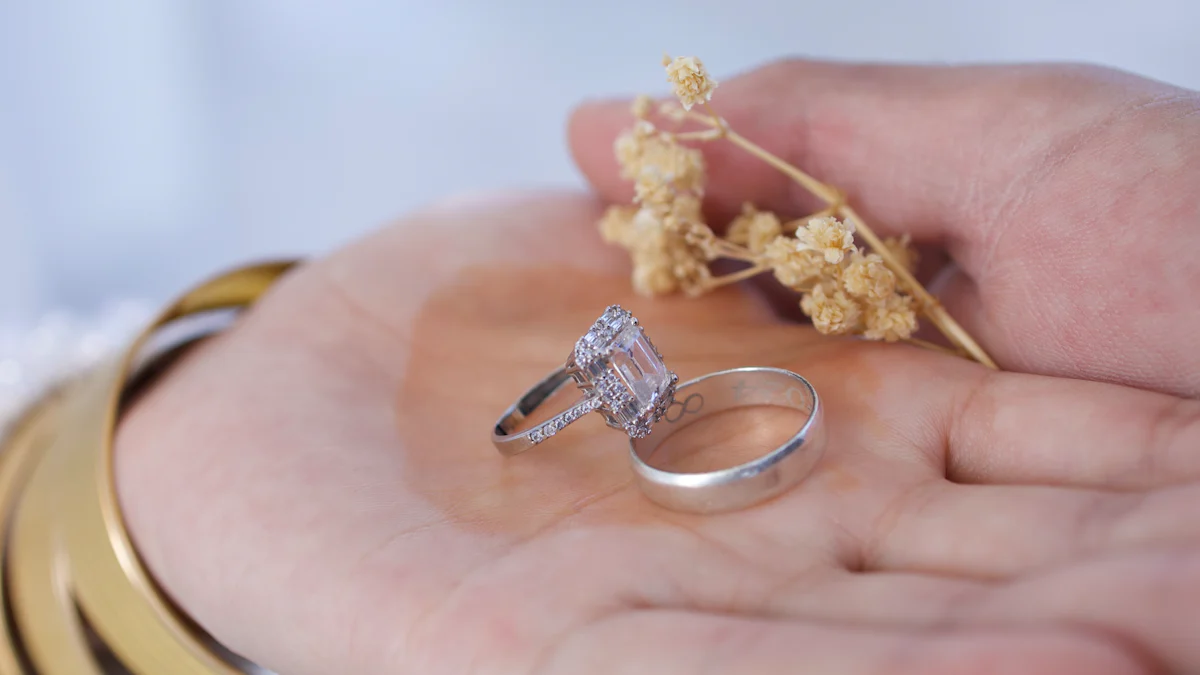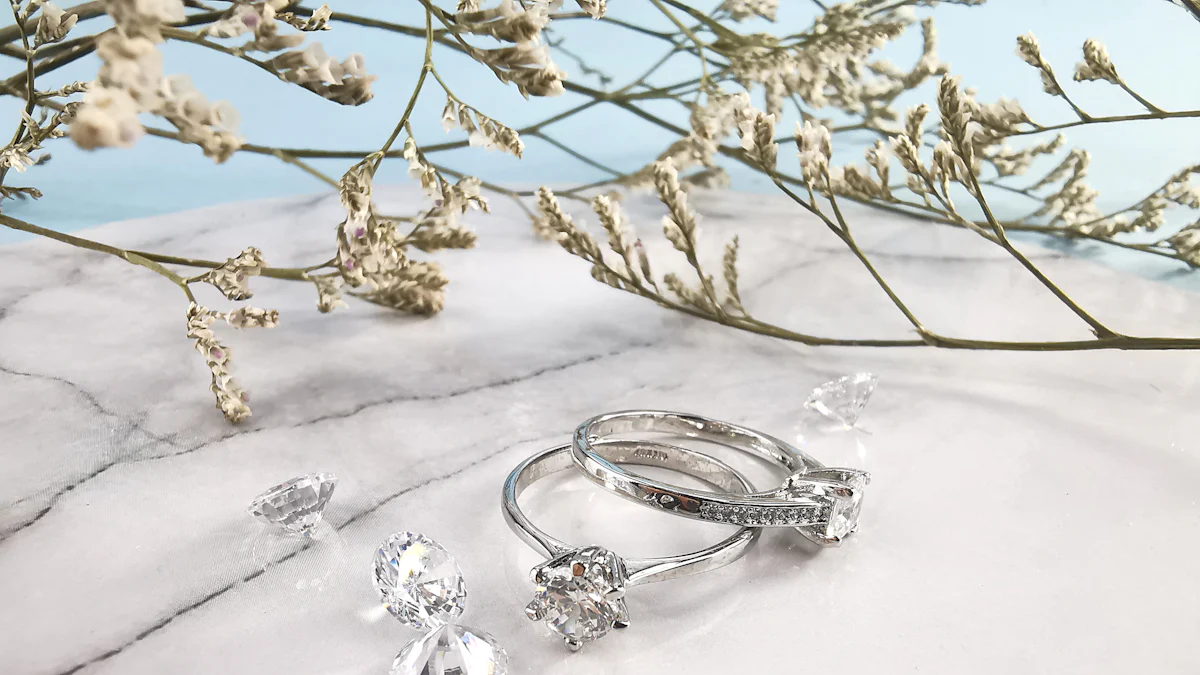Trends in Average Carat Size Engagement Rings

Engagement rings have always been more than just jewelry—they symbolize love, commitment, and personal style. Over time, the average carat size engagement ring has shifted, reflecting changes in culture, economy, and individual preferences. For instance, in North America, the typical carat size ranges from 1.0 to 1.2 carats, striking a balance between affordability and visual impact. Meanwhile, younger couples often lean toward larger stones, with sizes between 1 and 2 carats becoming increasingly popular. These trends highlight how your choice of carat size can tell a unique story about your relationship and values.
Key Takeaways
- The average carat size for engagement rings in the U.S. is between 1.0 and 1.2 carats, balancing affordability with visual appeal.
- Cultural and social trends significantly influence carat size preferences, with some cultures favoring larger stones as symbols of wealth and success.
- Lab-grown diamonds offer a cost-effective way to choose larger carat sizes without exceeding your budget, making them increasingly popular among couples. When selecting a diamond, prioritize quality over size; a well-cut diamond can appear more brilliant than a larger, lower-quality stone.
- Your personal style and lifestyle should guide your choice of carat size; consider practicality if you lead an active life.
- Trends can inspire your choice, but ultimately, select a ring that reflects your unique story and values, rather than simply following societal expectations.
A Historical Overview of Engagement Ring Carat Sizes

Early 20th Century: Modesty and Practicality
In the early 1900s, engagement rings reflected a sense of modesty and practicality. You would have seen smaller stones, often paired with intricate craftsmanship. Platinum became a popular choice for settings, offering durability and elegance. Colored gemstones, like sapphires and rubies, were also common, adding a touch of personality to the designs. During this time, the focus wasn’t on size but on the artistry and meaning behind the ring.
The Art Deco movement of the 1920s brought a shift in style. Rings featured geometric patterns and bold designs, yet the stones remained modest in size. This era celebrated creativity and innovation, but the average carat size engagement ring stayed relatively small compared to modern standards. The emphasis was on balance and sophistication rather than extravagance.
Mid-20th Century: The Rise of the Diamond Industry
By the 1950s, the diamond industry had transformed how people viewed engagement rings. De Beers’ iconic “A Diamond is Forever” campaign convinced couples that diamonds were the ultimate symbol of love. You might have noticed larger diamonds becoming more desirable during this period. Hollywood’s influence also played a role, as glamorous stars flaunted sparkling rings that symbolized prosperity and romance.
This era marked a turning point. Diamonds became the standard for engagement rings, and their size started to matter more. The average carat size engagement ring began to increase, reflecting the growing association between larger stones and success. Rings from this time often featured classic round cuts or elegant emerald cuts, emphasizing timeless beauty.
Late 20th Century to Early 2000s: Bigger is Better
The 1980s and 1990s embraced opulence and boldness. You might remember the rise of princess-cut diamonds, which became a favorite for their modern and striking appearance. Engagement rings grew larger, with many couples opting for designs that showcased their wealth and status. Flamboyant styles dominated, and the focus shifted to making a statement.
By the early 2000s, the trend of “bigger is better” reached its peak. The average carat size engagement ring climbed steadily, with many couples choosing stones over 1 carat. This period also saw a mix of traditional and non-traditional designs. For example, Princess Diana’s sapphire ring inspired a wave of unique gemstone choices, proving that individuality could shine alongside grandeur.
What is the Average Carat Size Engagement Ring Today?
Current Data on Average Carat Sizes
When it comes to engagement rings, the average carat size has become a fascinating topic. In the United States, the typical diamond size for an engagement ring falls between 1.0 and 1.2 carats. This range strikes a balance between affordability and visual appeal, making it a popular choice for many couples. However, younger couples often lean toward larger stones, with diamonds between 1 and 2 carats gaining traction in recent years.
Interestingly, lab-grown diamonds have started to influence this trend. These diamonds, which are identical to mined ones in appearance and quality, cost significantly less per carat. This affordability allows you to choose a larger stone without exceeding your budget. As a result, lab-grown diamonds have contributed to an increase in the average carat size engagement ring, offering more options for couples who want a bigger sparkle.
Economic factors also play a role in shaping these trends. During times of economic prosperity, people tend to spend more on engagement rings, often opting for larger diamonds. On the other hand, during tougher financial periods, couples prioritize quality over size, choosing smaller but higher-quality stones. This balance ensures that the ring remains meaningful while staying within budget.
Variations by Demographics and Regions
The average carat size engagement ring varies significantly depending on where you live. In North America, diamonds between 1.0 and 1.2 carats dominate the market. However, in Europe, couples often prefer smaller stones, with the average size ranging from 0.5 to 0.6 carats. This difference reflects cultural preferences, as Europeans tend to value modesty and subtlety in their jewelry choices.
Regional differences within the United States also stand out. Couples in metropolitan areas or regions with higher incomes often choose diamonds that are 2 carats or larger. In contrast, those in rural or less affluent areas stick closer to the national average of 1 carat. Age also influences preferences. Younger couples frequently opt for larger stones, while older couples lean toward higher-quality diamonds, even if they are smaller.
Global trends, such as the rise of lab-grown diamonds, further impact these variations. These diamonds have gained popularity worldwide, making larger stones more accessible to couples in different regions. Whether you’re in the U.S., Europe, or elsewhere, the availability of affordable options has reshaped how people approach carat size.
Ultimately, the "average" carat size depends on your personal style, budget, and cultural influences. Whether you prefer a modest diamond or a bold statement piece, the choice should reflect your unique story.
Factors Influencing Carat Size Preferences
When choosing an engagement ring, the carat size often reflects more than just a preference for sparkle. It ties into cultural norms, financial priorities, and your unique sense of style. Let’s explore the key factors that influence carat size preferences.
Cultural and Social Trends
Cultural values and social expectations play a big role in shaping what you might consider the "ideal" carat size. In some cultures, larger diamonds symbolize wealth and success, making them a popular choice for engagement rings. In others, modesty and subtlety take precedence, leading to smaller stones being favored.
Social media has also amplified trends in recent years. Platforms like Instagram and Pinterest showcase extravagant rings, often influencing couples to lean toward larger stones. Celebrity engagements further fuel this trend. When you see stars flaunting massive diamonds, it can create a perception that bigger is better. However, not everyone follows these trends. Many people still prioritize meaningful designs over size, focusing on what feels personal and timeless.
Budget Considerations
Your budget often determines the carat size of your engagement ring. Larger diamonds come with a higher price tag, so balancing size with affordability becomes essential. Many couples today prioritize the diamond’s cut and quality over its size. A well-cut diamond can appear larger and more brilliant, even if it has a smaller carat weight.
Lab-grown diamonds have also changed the game. These diamonds cost significantly less than mined ones, allowing you to choose a larger stone without breaking the bank. For example, if you’re working with a limited budget, a lab-grown diamond might let you achieve the look you want while staying within your financial limits.
Economic factors, such as inflation or changes in spending habits, also influence carat size preferences. During prosperous times, couples may feel more comfortable investing in larger diamonds. In contrast, during economic downturns, smaller but high-quality stones often become the go-to choice.
Personal Style and Lifestyle
Your personal style and daily lifestyle should guide your decision on carat size. If you prefer bold and eye-catching jewelry, a larger diamond might suit you best. On the other hand, if you lean toward minimalist or understated designs, a smaller stone could align better with your aesthetic.
Lifestyle matters too. If you lead an active life or work with your hands often, a smaller diamond might be more practical. Larger stones can sometimes feel cumbersome or prone to damage in such situations. Additionally, the shape and cut of the diamond can affect how big it looks. For instance, oval or marquise cuts tend to appear larger than round ones of the same carat weight.
Ultimately, the right carat size depends on what feels authentic to you. Whether you choose a modest diamond or a bold statement piece, the most important thing is that your ring reflects your personality and values.
How to Choose the Right Carat Size for Your Engagement Ring

Choosing the right carat size for your engagement ring can feel overwhelming, but it doesn’t have to be. By focusing on a few key factors, you can find a ring that fits your style, budget, and lifestyle perfectly. Let’s break it down step by step.
Balancing Size, Quality, and Budget
When selecting a diamond, balancing size, quality, and budget is essential. A larger diamond might catch your eye, but it’s not always the best choice. The diamond’s cut, clarity, and color often have a bigger impact on its sparkle and beauty than its size. For example, a well-cut diamond with excellent clarity can appear more brilliant than a larger stone with flaws.
If you’re working within a budget, consider prioritizing quality over size. Lab-grown diamonds offer an excellent option here. They cost significantly less than mined diamonds, allowing you to choose a larger carat size without compromising on quality. As one jeweler explains:
"While a larger carat size might seem impressive, it isn’t the sole indicator of a ring’s allure. Prioritizing a diamond’s cut and clarity ensures brilliance and fire, even if the carat weight is smaller."
By focusing on these aspects, you can find a diamond that looks stunning without exceeding your financial limits.
Considering Ring Design and Finger Size
The design of the ring and the size of your finger play a big role in how the diamond looks. A smaller diamond can appear larger on a delicate band, while a bold setting might make a larger stone feel more balanced. Certain cuts, like oval or marquise, also create the illusion of a bigger diamond, even if the carat weight is modest.
Your finger size matters too. A 1-carat diamond might look substantial on a smaller finger but less noticeable on a larger one. If you’re unsure, try on different styles to see what feels right. Jewelers often recommend considering the overall harmony of the ring. The diamond should complement the design without overpowering it.
The Importance of Personal Preference
At the end of the day, your personal preference matters most. Trends and societal expectations shouldn’t dictate your choice. Whether you prefer a modest diamond or a bold statement piece, the ring should reflect your personality and values.
Think about your lifestyle as well. If you lead an active life or work with your hands, a smaller diamond might be more practical. On the other hand, if you love making a statement with your jewelry, a larger stone could be the perfect fit. Remember, the "average carat size engagement ring" is just a guideline. What matters is finding a ring that feels meaningful to you.
Take your time, explore your options, and consult with a trusted jeweler. Their expertise can help you navigate the nuances of diamond selection, ensuring you make a choice you’ll cherish forever.
Engagement ring trends have evolved, but the meaning behind them remains timeless. The average carat size engagement ring today reflects a mix of cultural influences, economic realities, and personal choices. Your decision should balance size, quality, and budget while staying true to your style. Whether you prefer a modest diamond or a bold centerpiece, the right ring is the one that feels uniquely yours. Remember, it’s not about following trends—it’s about celebrating your love in a way that resonates with you.
FAQ
What is the significance of carat size for an engagement ring?
Carat size plays a big role in how an engagement ring looks and feels. It affects the overall appearance of the diamond and its cost. A larger carat size often creates a more dramatic visual impact, while a smaller size can feel delicate and understated. Choosing the right carat size helps you balance aesthetics, budget, and personal style. Remember, the perfect carat size is the one that feels meaningful to you.
Does a bigger diamond always mean better quality?
Not necessarily. A diamond’s quality depends on factors like cut, clarity, and color, not just its size. A smaller diamond with excellent cut and clarity can sparkle more brilliantly than a larger one with flaws. Focus on these aspects to ensure your diamond looks stunning, regardless of its carat size.
How does carat size affect the price of an engagement ring?
Carat size significantly impacts the price of a diamond. Larger diamonds are rarer, so their cost increases exponentially with size. However, you can find a balance by prioritizing quality over size. For example, lab-grown diamonds offer a cost-effective way to choose a larger carat size without overspending.
What is the average carat size for engagement rings in the U.S.?
In the United States, the average carat size for engagement rings typically falls between 1.0 and 1.2 carats. This range offers a balance between affordability and visual appeal. However, preferences vary widely based on personal style, budget, and regional trends.
Are lab-grown diamonds a good option for larger carat sizes?
Yes, lab-grown diamonds are an excellent choice if you want a larger carat size without exceeding your budget. These diamonds are identical to mined ones in appearance and quality but cost significantly less. They allow you to prioritize size and quality simultaneously.
How do cultural differences influence carat size preferences?
Cultural values shape what people consider the "ideal" carat size. In some cultures, larger diamonds symbolize wealth and success, while others value modesty and subtlety, favoring smaller stones. Understanding these differences can help you choose a ring that aligns with your values and traditions.
Does finger size affect how a diamond looks?
Yes, finger size influences how a diamond appears. A smaller diamond can look larger on slender fingers, while a larger diamond may feel more proportional on wider fingers. Trying on different styles helps you find the right balance for your hand.
What are some tips for choosing the right carat size?
Here are a few tips to guide you:
- Prioritize quality over size: A well-cut diamond will sparkle more, even if it’s smaller.
- Consider your lifestyle: If you’re active, a smaller diamond might be more practical.
- Try different designs: Certain settings and cuts can make a diamond appear larger.
- Stick to your budget: Lab-grown diamonds can help you achieve the look you want without overspending.
Can the ring setting impact how big the diamond looks?
Absolutely. The design of the ring can enhance the diamond’s appearance. For instance, a halo setting surrounds the center stone with smaller diamonds, making it look larger. Thin bands or certain cuts, like oval or marquise, also create the illusion of a bigger diamond.
Should I follow trends when choosing carat size?
Trends can provide inspiration, but your choice should reflect your personal style and values. Whether you prefer a modest diamond or a bold statement piece, focus on what feels authentic to you. The most important thing is that your ring symbolizes your love and commitment.
See Also
Emerging Engagement Ring Styles You Need to Know
The Rise of Diamond Ring Pops in Engagements
Unveiling the Best Engagement Ring Designs for 2024

